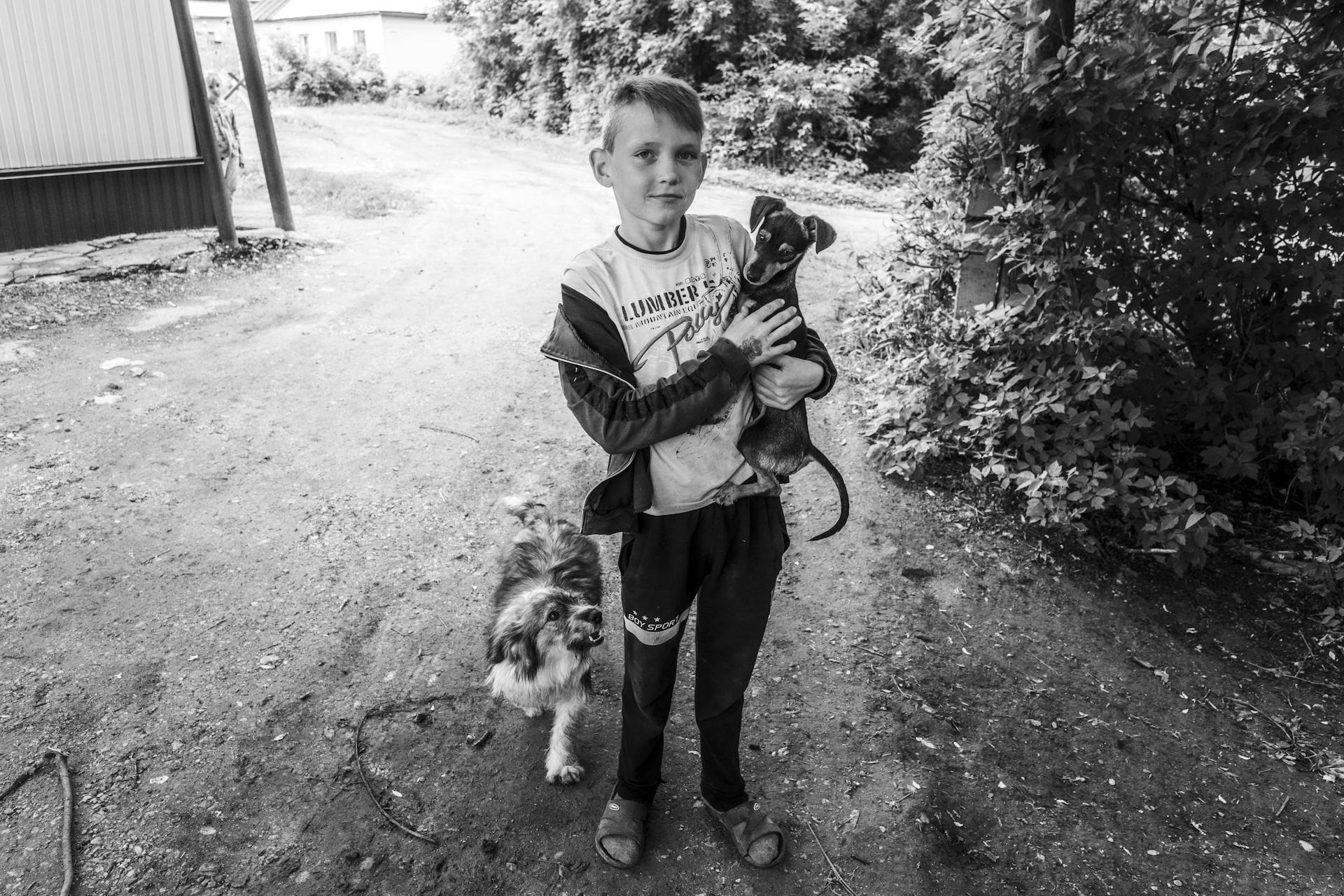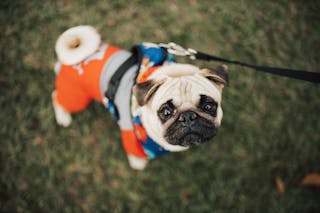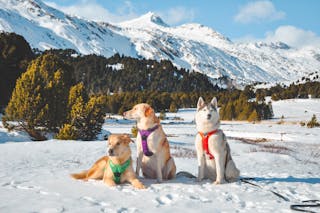
Dogs pant in the car for a variety of reasons, some of which are instinctual and out of pure comfort.
The primary cause dogs pant in cars is due to the temperature difference between the inside cabin and outside atmosphere. Dogs can easily overheat or become too cold if they are not exposed to an adequate climate while they are locked inside the vehicle. Panting allows them to take deep breaths in order to regulate their body temperature - cooling them off when it's hot and warming them up when it's cold. This behavior is especially common during summer months, where their fur coat can trap heat in, making it significantly more difficult for them to cool down naturally.
While physical temperature regulation plays a big role as to why dogs pant heavily on car rides, there has been some speculation that anxiety could also be a possible factor - as dogs often learn to associate travel with anxious events such as vet visits or separation from home after long trips away from home. By repeatedly panting on car rides your canine companion is likely sending out alerts saying "I'm uncomfortable".
If you find that your pup consistently pants while travelling then it may be best consulting with an animal behavior specialist so that you can come up with effective strategies regarding calming your pooch before getting back on the road!
Why do dogs become anxious in the car?
Car anxiety, or "motion sickness," is a common problem for our canine pals that can make travelling in the car extremely uncomfortable or even dangerous. For many dogs, the source of this anxiety is rooted in their physiology and emotional makeup.
First, dogs are sensitive to motion because of their vestibular system—the inner ear structure responsible for balance and motion detection. When a dog experiences movement (such as while riding in a car) they often become disoriented and feel nauseous since they've picked up on all the changes with their sensitive organs. These physical sensations then trigger fear and anxiety responses due to their past experiences; if a dog has had bad experiences with cars before (such as getting car sick), it's likely that he or she will be more apprehensive about subsequent rides.
Second, some dogs may develop general anxieties about cars due to lack of exposure and socialization: If a puppy didn't experience regular car rides during its first few months of life before developing an understanding of vehicle safety protocols, it could cause them to become uneasy when confined in an unfamiliar space like a moving one. Allowing your pup plenty of opportunities to explore vehicles early on can help them learn not only how to stay calm while riding but also how fascinating trips can be!
Ultimately, there are several reasons why dogs may be anxious while riding in cars—but these anxieties don't have to limit your pooch's ability to travel safely! Working together with your pup's vet—or better yet, bringing him or her along for regular visits to the groomer—will both create positive associations with vehicles so you can enjoy quality time on the go together.
Why do some dogs bark uncontrollably in the car?
Some dogs bark uncontrollably in the car because they are feeling anxious, uncomfortable and/or out of control. Riding in a car can be a strange, new experience for some dogs, especially if they haven't been exposed to it before. They may feel scared and confused as there are lots of unfamiliar sights and sounds that can be overwhelming. Additionally, the confined space of the car is likely to add to their anxiety as they may lack ample room to move around or escape from what is disturbing them.
If your dog starts barking uncontrollably in the car though, it's important not to punish them for their behavior since this will only make things worse and create even more fear around riding in cars. Rather focus on identifying why exactly your dog is anxious while riding and then take steps such as desensitizing them with shorter drives at first or providing comfort items like toys or blankets that will help them feel safer and more secure while being transported by vehicle.
What causes panting in dogs when they are riding in a car?
Panting in dogs when they are riding in a car is a common issue and it can be caused by multiple factors. One of the most common causes is anxiety or stress. It's natural for dogs to feel anxious when they're in a vehicle that they are unfamiliar with and going to an unknown destination. Being enclosed in a small space can also be cause for anxiety, so having plenty of ventilation can help alleviate some of their disturbances.
Other potential causes of panting during rides are motion sickness or nausea, boredom or restlessness, or exposure to high temperatures/humidity levels within the car that make it difficult for them to stay comfortable. Additionally, some breeds tend to get more anxious than others while riding in cars - these would include herding breeds such as Border Collies and Corgis, who have been bred to chase after things like sheep and cattle hence their anxiousness at high speeds behind vehicles like cars!
If your pup tends to pant heavily during rides then there are few ways you can help them relax such as playing calming music (like classical songs) within the exterior environment combining both interior calmness with exterior peaceful noise; getting an appropriate pet seatbelt for your dog so that he/she does not fly around at high speeds; bringing along treats like carrots or apple slices (if allowed) which helps keep them distracted from focusing on what might be causing their anxieties; providing regular restroom stops along the journey; opening up windows enough so that your pup gets fresh air without being overly exposed; making sure you don’t use sudden brakes while driving etc., As always though, if you notice any other associated symptoms such as vomiting then it’s best to speak with your veterinarian right away!
What can owners do to help relax their dogs in the car?
If your dog has a tendency to become stressed out during car rides, there are plenty of ways that you can help calm their anxiety and ensure that the ride is as comfortable for them as possible. Here are a few tips you can use to help relax your pup in the car:
1. Make Sure Your Dog is Comfortable: Make sure your car is set up so that your pup feels comfortable and secure, with ample space to move around. Provide them with a cozy blanket or bed that they can snuggle in while they ride. Additionally, if it’s safe to do so, try opening the windows slightly so they can take in all the sights and smells our world has to offer!
2. Desensitize Your Dog: Before taking on any long trips, slowly introduce short drives in your car around town with favorable outcomes like going for walks when you reach the destination or offering treats throughout the journey - whatever works best for your furry friend! This will slowly but steadily teach them it's not always a bad thing getting into a car.
3. Stay Calm: To keep tension from escalating between yourself and your pup, try distracting them by playing games like hide-and-seek or just simply talking softly if allowed - anything calming which distracts their attention away from feeling overwhelmed by where they are going will suffice nicely!
4 Redirect Their Attention: Whenever possible during long trips give opportunities for short rest stops so that dogs may have time to explore new surroundings off leash (if this occurs make sure it’s done responsibly). If a rest stop isn't necessary then break up longer journeys with occasional healthy treats and toys!
At lastly remember – we too get stressed out sometimes when traveling; never be afraid of getting professional guidance from animal professionals if worries persist about having an anxious pup in tow during travels!
Does panting in a car indicate that a dog is in distress?
Panting in a car is not necessarily an indication that your dog is in distress, but it can be – depending on the circumstances. Most often, panting in a car means that your dog is hot and trying to cool off. The small space of the car amplifies their body heat and can cause them to pant more than normal. If your dog is pacing, whining or shaking then these behaviors may be indicators of distress.
When a dog pants heavily in cars it’s also possible that they are anxious about the upcoming trip. Whether you’re just running errands around town or going for a longer drive some dogs become very nervous at the thought alone and may start panting right away as a result of uncertainty or fear. Carsickness can also be accompanied with panting as they feel nauseous or experiencing motion sickness while traveling.
The best way to determine if you should take action to help reduce any underlying distress your pup could potentially feel while being inside of cars, look out for changes in behavioral cues associated with fear and anxiety such as urination or defecation inside the car, barking excessively, trying to hide under seats etc -all which signals stress levels are too high making moving vehicles an uncomfortable environment for them; therefore count relaxation techniques such as natural remedies like Adaptil (dog appeasing pheromone) scented necklaces/jewelry for time spent traveling by car into account during these unsure times too!
How can owners help their dogs cope with car rides?
Taking car rides with your dog can be a great bonding experience, but it’s important to remember that not all dogs are comfortable in the back seat. Many pet owners struggle to find ways to help their dogs relax and cope with the stress of long and short car rides. Here are some tips for helping your dog have a comfortable time during any car ride:
1. Help your Dog Get Acclimated Early: Introducing your dog to the car early on in life can help them become more accustomed and comfortable riding in it. Take short trips around town or take them out on errands they normally wouldn’t be part of (such as going grocery shopping).
2. Provide Comfort Items Such as Blankets and Toys: Having something familiar from home such as extra blankets, or their favorite toy or chew item can make them feel more secure while traveling. Make sure there are plenty of opportunities for potty breaks so that your pup doesn't have to "hold it."
3. Create Positive Associations During Rides: Provide treats before, during, and after car rides so that they come associate getting into a vehicle with positive reinforcement rather than feeling scared or anxious about the situation.
4. Distraction is Key: Creating diversions from different sights outside the vehicle can keep your pup preoccupied throughout trips both long and short so they aren’t focusing on any potential fears surrounding being inside a car setting up an association with riding in cars is fun rather than fearful! Listening to calming music, playing fetch games together using soft toys within range of their harnesses/seats, even providing snuffle mats filled with small snacks hidden losely within their blankets has been known to ease some of their travel anxieties too!
By taking these steps ahead of time you should create an environment where everyone involved is comfortable; furbabies included ;). Regularly using these tactics will help build solid associations between Car Time & Happy Time! Best wishes🐾



